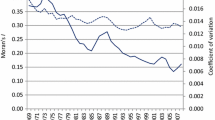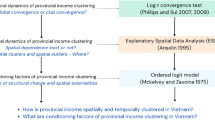Abstract
Regional interaction is generally understood as implying movement between regions at the same level of an hierarchy. This paper extends the notion to include an hierarchical system, thus facilitating the consideration of vertical interaction in the analysis of regional interaction. Obviously, vertical interaction is not altogether a new concept. One could find this concept in many analyses related to national-local or federal-state relationships. This paper treats hierarchy in a strict sense; spatial units are interacting one with another within, but not between, presumed super regions. A particular example drawn in this paper is the province-region relationships for the case of Indonesia. In this framework, provinces form a region, and regions form the nation. The Dendrinos–Sonis model is then used as the basis for measuring the hierarchical spatial interaction in Indonesia. The analysis will explore the degree to which complementarity and competitive interaction revealed at one level in the hierarchy persist at lower or higher levels.



Similar content being viewed by others
Notes
This way of understanding regional interaction is different from those defining regional interaction that is agent-based. An example of agent-based definition of regional interaction is provided in Poot (2000, 205) where he defines regional competition, which is one type of interactions, as actions of economic agents that are taken to enhance the standard of living of their own territories, such as regions, cities, or countries.
The term product and income should have different meaning at the regional level. However, we ignore such distinction in this paper. Hence, the two terms will be used interchangeably.
SUR technique on Eq. 4 will yield the same estimates as those obtained with the ordinary least square (OLS) estimator. The reason is simply the fact that each of n - 1 equation in Eq. 4 has exactly the same set of explanatory variables (Judge et al. 1988). The use of SUR here is justified by its greater efficiency than OLS.
For further exposition on the spatial econometrics technique involving the use of spatial weight matrix, look at Anselin (1988).
That fact raises another issue to address, which is beyond the scope of this paper, i.e., the appropriateness of the spatial categorization. This question carries many different concerns, among them are the appropriate level of structure for the analysis, should vertically hierarchical structure be defined in accordance with the term nodal or functional regions or administrative regions, etc.
This is the old 27-province system minus East Timor, who became an independent country in 1999.
There are several other regionalizations that are common, for instance, 'Java' and 'outer islands'. Another commonly used regionalization is the 'western' and 'eastern' parts of Indonesia. The former refers to Java and Sumatra (and sometimes also includes Bali), and the latter is the rest of the country.
Some other studies have also confirmed the existence of regional convergence within a country, e.g., Barro and Sala-i-Martin (1995) for the case of US states and Japanese prefectures. For the case of developing countries look at Cashin and Sahay (1996) for the convergence among 20 states in India. From the theoretical point of view, the convergence among sub-nations is sparked by the relatively homogenous conditions of exogenous variables. In terms of the Solow growth model, the exogenous variables may be the saving rates, population or labor supply growth, depreciation, or rate of technical progress.
We use the provincial numbering system to make table reading easier. Note that this numbering system is different from one officially used by the Central Bureau of Statistics.
Note again that it is assumed that provinces of different regions do not interact directly. Recall the strictly hierarchical structure as presented in Fig. 1.
References
Anselin L (1988) Spatial econometrics: methods and models. Kluwer, Dordrecht
Barro R, Sala-i-Martin X (1995) Economic growth. McGraw-Hill, New York
Cashin P, Sahay R (1996) Regional economic growth and convergence in India. Finance Dev 33(1):49–52
Dendrinos D, Sonis M (1988) Nonlinear discrete relative population dynamics of the US regions. Appl Math Comput 25:265–285
Dendrinos D, Sonis M (1990) Chaos and socio-spatial dynamics. Springer, Berlin Heidelberg New york
Funck RH (2000) Hard and soft determinants of interregional competition. In: Batey PWJ, Friedrich P (eds) Regional competition. Springer, Berlin Heidelberg New York, pp 66–85
Garcia JG, Soelistianingsih L (1998) Why do differences in provincial incomes persist in Indonesia? April 1998. Bull Indones Econ Stud 34(1):95–120
Hewings GJD, Sonis M, Cuello FA, Mansouri F (1996) The role of regional interaction in regional growth: competition and complementarity in the US regional system. Aust J Reg Stud 2:133–149
Johansson B (2000) Regional competition: endogenous and policy-supported processes. In: Batey PWJ, Friedrich P (eds) Regional competition. Springer, Berlin Heidelberg New York, pp 34–65
Judge GG et al (1988) Introduction to the theory and practice of econometrics, 2nd edn. Wiley, New York
Magalhaes A, Sonis M, Hewings GJD (2001) Regional competition and complementarity reflected in relative regional dynamics and growth of GSP: a comparative analysis of the Northeast of Brazil and the Midwest States of the US. In: Joaquim JM Guilhoto, Geoffrey JD Hewings (eds) Structure and structural change in the Brazilian Economy. Aldershot, Ashgate
Mankiw NG, Romer D, Weil DN (1992) A contribution to the empirics of economic growth. Q J Econ 107:407–437
Nazara S (1999) Provincial Convergence Within the Neoclassical Growth Theory in Indonesia. In: Paper presented at 21st conference of northeast section of regional science association international (RSAI), held by Cornell University and SUNY Binghamton, Ithaca, May 7–8
Nazara N, Hewings GJDD, Sonis M (2001) Interregional competition and complementarity in Indonesia. Discussion Paper, 01-T-02, Regional Economics Applications Laboratory, University of Illinois, Urbana
Poot J (2000) Reflections on local and economy-wide effects of territorial competition. In: Batey PWJ, Friedrich P (eds) Regional competition. Springer, Berlin Heidelberg New York, pp 205–230
Richardson HW (1973) Regional growth theory. Macmillan, Bristol
Resosudarmo BP, Wuryanto LE, Hewings GJD, Saunders L (1999) Decentralization and income distribution in the interregional Indonesian economy. In: Hewings GJD, Sonis M, Madden M, Kimura Y (eds) Understanding and interpreting economic structure, advances in spatial sciences. Springer, Berlin Heidelberg Germany
Sonis M, Hewings GJD, Jiemin G, Edison H (1997) Interpreting spatial economic structure: feedback loops in the Indonesian interregional economy, 1980, 1985. Reg Sci Urban Econ 27:325–342
Sonis M, Hewings GJD (2000) Regional competition and complementarity: comparative advantages/disadvantages and increasing/diminishing returns in discrete relative spatial dynamics. In: Batey PWJ, Friedrich P (eds) Regional competition. Springer, Berlin Heidelberg Newyork, pp 139–158
Author information
Authors and Affiliations
Corresponding author
Rights and permissions
About this article
Cite this article
Nazara, S., Hewings, G.J. & Sonis, M. An exploratory analysis of hierarchical spatial interaction: the case of regional income shares in Indonesia. J Geograph Syst 8, 253–268 (2006). https://doi.org/10.1007/s10109-005-0016-3
Received:
Accepted:
Published:
Issue Date:
DOI: https://doi.org/10.1007/s10109-005-0016-3




